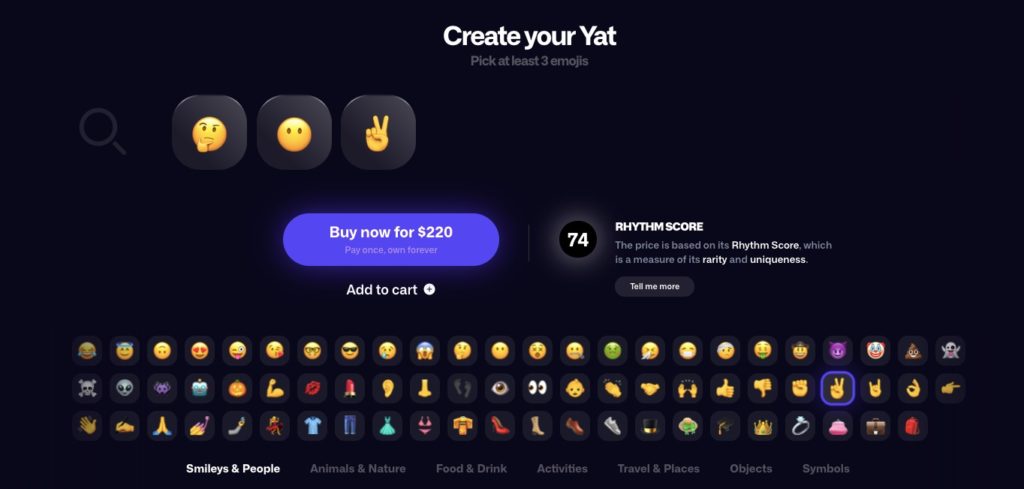Over Easter weekend we all ape’ed into Yats as the hype got real around their ‘Yat 100 Destiny drop’, with some 1-3 character IDs even selling from a range of tens of thousands to the low hundreds. But what are people actually buying when they buy a Yat? Well, right now it seems like the promise of an NFT backed by some of the founders of Monero, a reputable privacy based blockchain protocol.
This Yat drop seems to be the 3rd one of 2021, with the project now boasting over 30k users on discord. The first being for 500 limited edition Prism Keys, which unlocked access for future drops. And people are really, really excited by it.


Y.at lets you use emojis as your universal username and identity on the internet kinda like Linktree. For example: https://y.at/???????????? Linktree being a freemium social media reference landing page that serves a metalink for all your other social links, which was reported by Techcrunch to have 8 million users in 26 Oct 2020.
Cool, right? Here is where it gets a little confusing..
Are these even NFTs?
Well, no (not yet). Currently, all yats are on a central registry controlled and operated by the US based Emoji ID, LLC DBA Yat Labs, a Delaware limited liability company and presumably like any other Web 2 platform, by a group of admins. Neglecting the security implications, one of the reasons this is important to people buying into the project, especially those investing at the higher end much in the way would speculate on web domains (aka URLs), is because they can believe they can sell them for a profit. However, unlike most actual NFT projects, Yats are not transferable (as of yat), not on the y.at platform itself nor in secondary markets like OpenSea.
In fact in their T&Cs it explicitly forbids transferability;
There has been some speculation by its advocates (and there are many) that Yats will at some point turn into NFTs, allegedly on Tari a side-chain on Monero, a privacy preserving blockchain, with the promise you would be able to anonymously and cryptographically prove your identity in a fully ‘censorship resistant’ way. Censorship resistance is another claim made by the team on the website and in various communications but what does that mean?
Well in the context of crypto it generally means no one company or government can effectively censor or deplatform the user.
However, if you look at the project’s T&Cs it clearly states the platform can terminate or suspend your account at their own discretion and without warning, and that it complies with US Laws and that all content (presumably including y.ats) remain the property of the company, much in the same way your Twitter account is the property of Twitter Inc.
Is it Self Sovereign?
Another word used a lot in official and unofficial discussion around the project is ‘sovereign’. This idea is both in the context of Yat being a form of identity (SSI: Self Sovereign Identity) and wealth. The idea being you and only you have custody and control of these things. But SSI has decades of development at the World Wide Web Consortium setup by Tim Berners Lee (the inventor of The Web) often referred to as W3C and an identity working group called DID (decentralised identifiers) and has come to mean a very specific thing. Whilst the team don’t directly reference SSI they do infer it, but again there is very little information about how they will achieve it.
And some critics argue by having already associated a Yat with both a credit / debit card and email for signup they have already contaminated it ever being able to allow for any meaningful privacy based communication or transfer of digital money.
How real is the tech?
The team and its advocates are at pains to point out whilst many of these challenges are true the project is still early in its development. On their T&Cs (unlike on their homepage) the logo changes to include ‘Alpha’.
An Alpha Release is the release when the feature which you are developing is incomplete or partially complete. Beta Release finishes when the product feature is complete and all the development has finished, but there are possibilities it could contain some bugs and performance issues.
Can’t you already do this with ENS names?
So being able to add emojis into a URL is not new in Web 3. You can already use emojis with an .ETH address. That is a fully onchain, ethereum based domain with all the qualities described by y.at. However, you’d have to jump through a few hoops to set it up, complete with usual Web 3 friction of using a metamask wallet which would put most normies off.
The team
What’s strange about the project is that the people behind it (Richard Spagni and Naveen Jain) are not novices, but world-leading privacy experts and seasoned founders and investors in crypto, leading many to give them the benefit of the doubt that they will deliver on the promises to users and that there must be some reason for them to not share more technical details.
Listed both as co-founders of Tari Labs, Tari was founded in 2018 by Monero maintainer Riccardo Spagni, and entertainment entrepreneurs Naveen Jain and Dan Teree. The protocol is headquartered in Johannesburg and with offices in California. Naveen is an investor with a near decade track record and Richard is a core contributor to Monero.
It is understood the project is also backed by a highly regarded group of investors including Repoint Capital, Trinity Ventures, Pantera Capital, Blockchain Capital, and Canaan Partners. This is to quote their Messari profile page ‘due to Riccardo Spagni’s preference for VC funding and his disdain for controversial funding sources like ICO’s’.
One of the cofounders, Richard, has now gone on to acknowledge that some of the language they used in marketing the project is misleading but claims it to be accidental. Given his background in maintaining highly specialised privacy preserving blockchains and being a self-professed SSI expert it seems strange he would make such mistakes.
Putting aside the team’s best intentions those familiar with early stage startups (especially those in alpha) there is always ‘execution risk’ and it’s always possible potential issues, both in and out of the team’s control, can impede them actually delivering on their promises. Raising questions of will users ever get fully transferable NFTs for their money.
As an example the last attempt at a decentralised universal identifier was Onename.io back in 2014 founded by Muneeb Ali and Ryan Shea, which later became the basis for Blockstack, but has struggled to yet go mainstream. And furthermore the game Blankos by Mythic Games which marketed their genesis drop as in game items that would be transferable as NFTs have only just announced it could be several more months before they are tradable.
Equally, as we enter the type of hype last seen during 2017 ICO mania, it is important and appropriate the community watch out for projects ‘NFT washing’ to raise funds and we demand they better disclose at the point of sale that rights a buyer does and doesnt have in the context of fully functioning NFTs.
Our concerns with y.at is for every day the project is centralised it compromises the security of users, their data and wealth. What has perhaps been most surprising is the lack of upfront transparency. Normally blockchain projects would publish technical papers about their architecture and design choices to be openly interrogated by the community of developers, but for some reason this is missing. Whilst it might be reasonable to say the average user doesn’t want or need this, those they rely on in the community to navigate its complexities do and given y.ats dependencies more disclosures around Tari and its roadmap feel reasonable.
Finally can emojis even work as a better internet ID?
Do emoji’s even work as a new form of identity? Well we think you can make a very strong argument that emoji’s are the internet’s meta language, and one that transcends all local languages. And let’s be honest, who doesn’t like NFTs. However some are asking are they actually any easier to remember than say a twitter handle?
Either way it’s sure worth a shot. And we certainly expect many projects working on universal ID to adopt emojis in this way. The question is will y.at deliver on the promises and live up to the hype? We hope so.



